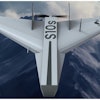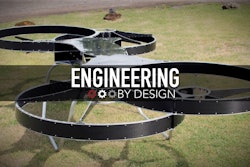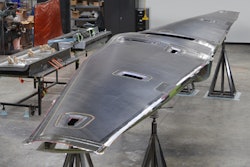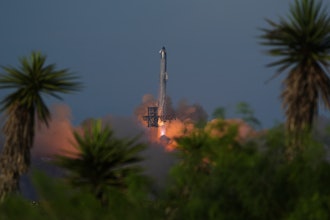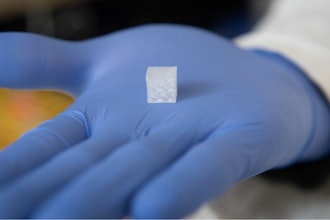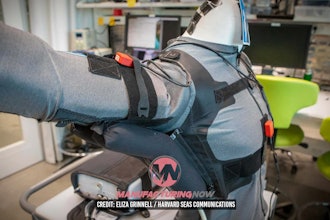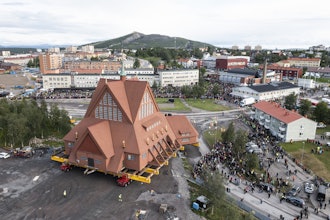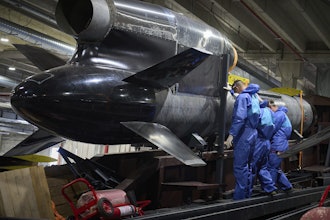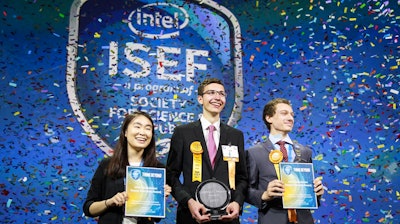
Ivo Zell, 18, of Lorch, Germany was awarded first place for designing and constructing a remote control prototype of a new “flying wing” aircraft at this year’s Intel International Science and Engineering Fair, a program of Society for Science & the Public and the world’s largest international pre-college science competition.
The competition featured nearly 1,800 young scientists selected from 425 affiliate fairs in 78 countries, regions and territories.
Flying wings are inherently more efficient than traditional aircraft designs, but also less stable in flight because they have little or no fuselage or tail.
Zell’s working prototype aircraft addresses this issue, using an unusual bell-shaped lift profile for improved stability and using telemetry to demonstrate its stability. The modified shape of Zell’s aircraft allows it to operate smoothly and safely in challenging flight situations without the need for a complex electronic stabilization system and without significantly sacrificing fuel efficiency.
Potential applications range from drone delivery systems to larger aircraft design. Zell received the Gordon E. Moore Award of $75,000, named in honor of the Intel co-founder and fellow scientist.
Amber Yang, 18, of Windermere, Florida received one of two Intel Foundation Young Scientist Awards of $50,000 for her innovative approach to predicting the locations of clouds of space debris that move in low Earth orbit.
An estimated 500,000 space trash objects now pose a potential hazard for spacecraft. Yang adapted an algorithm to train her own artificial neural network to recognize space objects in a specific debris cloud and predict their future locations.
Valerio Pagliarino, 17, of Castelnuovo Calcea, Italy received the other Intel Foundation Young Scientist Award of $50,000 for his prototype of a novel laser-based, wireless, high-speed network. Motivated by the lack of reliable Internet access in his rural locale, Pagliarino designed his new system using off-the-shelf components and then built and tested a small version of the network.
In addition to the top winners, approximately 600 finalists received awards and prizes for their innovative research, including 22 “Best of Category” winners, who each received a $5,000 prize.
The Intel Foundation also awarded a $1,000 grant to each winner’s school and to the affiliated fair they represent.
The following lists the 22 Best of Category winners, from which the top three were chosen:
| Category | First | Last | City | State/Country | |||||
| Animal Sciences | Jessica | Young | Wellington | Florida | |||||
| Behavioral and Social Sciences | Erin | Smith | Lenexa | Kansas | |||||
| Biochemistry | Karina | Movsesian | Karlovy Vary | Czech Republic | |||||
| Biomedical and Health Sciences | Daniel | Zhang | San Diego | California | |||||
| Biomedical Engineering | Clara | Wagner | Saginaw | Michigan | |||||
| Cellular and Molecular Biology | Davey | Huang | Honolulu | Hawaii | |||||
| Chemistry | Kyle | Fridberg | Boulder | Colorado | |||||
| Computational Biology and Bioinformatics | Prathik | Naidu | Potomac Falls | Virginia | |||||
| Earth and Environmental Sciences | Adam | Nayak | Portland | Oregon | |||||
| Embedded Systems | Valerio | Pagliarino | Castelnuovo Calcea | Italy | |||||
| Energy: Chemical | Kendra | Zhang | Jericho | New York | |||||
| Energy: Physical | Camille | Miles | Niceville | Florida | |||||
| Engineering Mechanics | Ivo | Zell | Lorch | Germany | |||||
| Environmental Engineering | Prashaant | Ranganathan | Jamshedpur | India | |||||
| Materials Science | Nicky | Wojtania | Plano | Texas | |||||
| Mathematics | Karthik | Yegnesh | Lansdale | Pennsylvania | |||||
| Microbiology | Rahul | Subramaniam | Cos Cob | Connecticut | |||||
| Physics and Astronomy | Amber | Yang | Windermere | Florida | |||||
| Plant Sciences | Isabella | Bowland | Boulder | Colorado | |||||
| Robotics and Intelligent Machines | Tassilo | Schwarz | Seeon | Germany | |||||
| Systems Software | Michael | Lee | Manhasset | New York | |||||
| Translational Medical Science | Jeremiah | Pate | Oro Valley | Arizona | |||||

